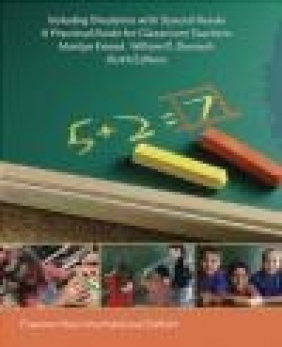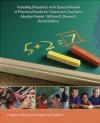Including Students with Special Needs
William Bursuck, Marilyn Friend
Including Students with Special Needs
William Bursuck, Marilyn Friend
- Producent: Pearson
- Rok produkcji: 2013
- ISBN: 9781292021416
- Ilość stron: 496
- Oprawa: Miękka
Niedostępna
Opis: Including Students with Special Needs - William Bursuck, Marilyn Friend
This single most-adopted Inclusion text worldwide continues to provide the best source of practical strategies for teaching students with special needs in inclusive settings. Filled with examples and vignettes, the emphasis is always on teaching methods that promote student independence at all education levels. Its non-categorical approach helps teachers ensure all students' success regardless of their specific categories of exceptionality. The Sixth edition integrates today's expectations for students with the authors' strong commitment to inclusive practices, tempered by the realities of day-today teaching. This text provides teachers with a firm grounding in special education practices, an understanding of the professionals who support these students and the procedures followed to ensure their rights are upheld, and a wealth of research-based strategies and interventions that can foster their success.Glossary C H A P T E R 1 The Foundation for Educating Students with Special Needs Learning Objectives What Key Terms and Concepts Define Special Education? Special Education Services Least Restrictive Environment Inclusive Practices How Did Today's Special Education Services Come to Exist? The Development of Education for Students with Disabilities The Impact of the Civil Rights Movement on Special Education The Legislative Basis for Contemporary Special Education What Factors Influence Practices in Today's Schools? Legislative and Related Policies Understanding of Inclusive Practices Impact on Students, Parents, and Educators Limited Resources Putting the Pieces Together Who Receives Special Education and Other Special Services? Categories of Disability in Federal Law A Cross-Categorical Approach to Special Education Other Students with Special Needs Wrapping it Up Back to the Cases Summary Applications in Teaching Practice:Understanding Contemporary Special Education C H A P T E R 2 Special Education Procedures and Services Learning Objectives Who Are the Professionals in Special Education? General Education Teachers Special Education Teachers Related Service Providers and Other Specialists Parents and Students How Can You Decide Whether a Student Need Might Be a Disability? Analyze Unmet Needs Communicate Your Observations and Try Your Own Interventions How Do Students Obtain Special Services? Initial Consideration of Student Problems The Special Education Referral, Assessment, Eligibility, Planning, and Placement Process Decision Making for Special Services Monitoring Special Education Services What Is an Individualized Education Program? Required Components of an IEP The Value of IEPs What Services Do Students with Disabilities Receive? Special Education and Related Services Student Placement and Educational Environments Wrapping it Up Back to the Cases Summary Applications in Teaching Practice: A Visit to an MDT Meeting C H A P T E R 3 Building Partnerships through Collaboration Learning Objectives What Are the Basics of Collaboration? Characteristics of Collaboration What Collaborative Services in Schools Foster Inclusion Shared Problem Solving Co-Teaching Working on a Team Consultation The Complexity of Professional Collaboration How Can You Work Effectively with Parents? Understanding the Perspective of Family Members Parents' Reactions to Their Child's Disability Collaborating with Parents How Can You Work Effectively with Paraprofessionals? Understanding Your Working Relationship with Paraprofessionals Collaborating with Paraprofessionals The Complexity of Collaborating with Paraprofessionals Wrapping it Up Back to the Cases Suumary Applications in Teaching Practice: Collaboration in the Washington School District C H A P T E R 4 Assessing Student Needs Learner Objectives How Do Your Student Assessments Contribute to Special Education Decisions? Screening Diagnosis Program Placement Curriculum Placement Instructional Evaluation Program Evaluation What Information Sources Are Used in Programming for Students with Special Needs? High-Stakes Achievement Tests Standardized Achievement Tests Psychological Tests Alternate Assessments Curriculum-Based Assessments What Kinds of Curriculum-Based Assessments Can You Create for Your Students? Probes of Basic Academic Skills Content-Area Assessments How Are Curriculum-Based Probes Used to Make Special Education Decisions? Peer Comparison in Screening Fluency and Accuracy in Diagnosis Skill Mastery and Curriculum Placement Monitoring Student Progress and Instructional Evaluation Wrapping it Up Back to the Cases Summary Applications in Teaching Practice: Collecting and Using Assessment Information C H A P T E R 5 Planning Instruction by Analyzing Classroom and Student Needs Learning Objectives How Can the INCLUDE Strategy Help You Make Reasonable Accommodations for Students with Special Needs? Step 1: Identify Classroom Demands Step 2: Note Student Learning Strengths and Needs Step 3: Check for Potential Areas of Student Success Step 4: Look for Potential Problem Areas Step 5: Use Information to Brainstorm Ways to Differentiate Instruction Step 6: Differentiate Instruction Step 7: Evaluate Student Progress How Is an Inclusive Classroom Managed? Physical Organization Routines for Classroom Business Classroom Climate Behavior Management Use of Time How Can You Group All Your Students for Instruction in Inclusive Classrooms? Whole-Class or Large-Group Instruction Small-Group Instruction One-to-One Instruction How Can You Evaluate Instructional Materials for Inclusive Classrooms? Learning Outcomes Textbooks Manipulatives and Models Technology How Can You Analyze Instructional Methods in Relation to Student Needs? Elements of Direct Instruction Indirect Methods of Instruction Scaffolding Independent Student Practice Evaluation of Student Performance Wrapping it Up Summary Back to the Cases Applications in Teaching Practice: Planning Accommodations in the Instructional Environment C H A P T E R 6 Students with Low-Incidence Disabilities Learning Objectives What Are Low-Incidence Disabilities? What Accommodations Can You Make for Students with Autism Spectrum Disorders? Characteristics of Students with Autism Spectrum Disorders Students with Asperger Syndrome Accommodations for Students with Autism Spectrum Disorders What Accommodations Can You Make for Students with Moderate, Severe, or Multiple Disabilities? Students with Moderate to Severe Intellectual Disabilities Students with Multiple Disabilities Deaf-Blindness What Accommodations Can You Make for Students with Sensory Impairments? Students with Visual Impairments Accommodations for Students with Visual Impairments Planning Instruction for Students with Visual Impairments Students with Hearing Loss Accommodations for Students Who Are Deaf or Hard of Hearing What Accommodations Can You Make for Students with Physical, Medical, or Health Disabilities? Orthopedic Impairments Teaching Students with Orthopedic Impairments Other Health Impairments Traumatic Brain Injury Wrapping it Up Back to the Cases Summary Applications in Teaching Practice: Planning for Students with Low-Incidence Disabilities C H A P T E R 7 Students with High-Incidence Disabilities Learning Objectives What Are High-Incidence Disabilities? What Accommodations Can You Make for Students with Communication Disorders? Understanding Speech Problems Understanding Language Problems Accommodations for Students with Communication Disorders What Are the Academic Needs of Students with Learning and Behavioral Disabilities? Reading Skills Written Language Skills Math Skills Learning Skills What Are the Social and Emotional Needs of Students with Learning and Behavioral Disabilities? Interpersonal Skills Personal and Psychological Adjustment What Accommodations Can You Make for Students with Learning and Behavioral Disabilities? Addressing Academic Needs Addressing Social and Emotional Needs Wrapping it Up Back to the Cases Summary Applications in Teaching Practice: Using the INCLUDE Strategy with Students with High-Incidence Disabilities C H A P T E R 8 Students with Special Needs Other Than Disabilities Learning Objectives Which Students Are Protected by Section 504? Understanding Section 504 Students Eligible for Services under Section 504 How Can You Accommodate Students with Attention Deficit-Hyperactivity Disorder? Characteristics and Needs of Students with Attention Deficit-Hyperactivity Disorder Interventions for Students with Attention Deficit-Hyperactivity Disorder Families of Children with Attention Deficit-Hyperactivity Disorder How Can You Accommodate Students Who Are Gifted and Talented? Characteristics and Needs of Students Who Are Gifted and Talented Interventions for Students Who Are Gifted and Talented What Are the Needs of Students from Culturally Diverse Backgrounds? Diversity and Special Education Cultural Awareness Families and Diversity Multicultural and Bilingual Education How Can You Meet the Needs of Students Who Are at Risk? Characteristics and Needs of Students at Risk Interventions for Students at Risk Wrapping it Up Back to the Cases Summary Applications in Teaching Practice: Diversity in a High School Class C H A P T E R 9 Differentiating Instruction Learning Objectives How Can You Make Accommodations for Students with Special Needs in Basic Skills Instruction? Teaching Preskills Selecting and Sequencing Examples Deciding the Rate of Introduction of New Skills Providing Direct Instruction and Opportunities for Practice and Review How Can You Make Accommodations for Students with Special Needs When Teaching Subject-Area Content? Activating Background Knowledge Organizing Content Teaching Terms and Concepts How Can You Improve Clarity in Written and Oral Communication? Clarity in Written Communication Clarity in Oral Communication How Can You Involve Parents in Teaching Their Children? What Accommodations Can You Make for Students to Help Them Succeed in Independent Practice? Differentiating Seatwork Assignments Differentiating Learning Center Activities Differentiating Homework Assignments Making Instructional Modifications for Students with Moderate to Severe Disabilities Wrapping it Up Back to the Cases Summary Applications in Teaching Practice: Developing a Repertoire of Instructional Accommodations C H A P T E R 10 Strategies for Independent Learning Learning Objectives How Can You Encourage Student Self-Awareness and Self-Advocacy? How Can You Effectively Teach Independent Learning Strategies in Class? Assess Current Strategy Use Clarify Expectations Demonstrate Strategy Use Encourage Students to Memorize Strategy Steps Provide Guided and Independent Practice Administer Posttests What Are Some Examples of Successful Learning Strategies? Word-Identification and Reading Fluency Strategies Vocabulary Strategies Reading Comprehension Strategies Listening and Note-Taking Strategies Writing Strategies Strategies for Using Technology to Improve Student Writing Strategies for Problem Solving in Math Strategies for Managing Time and Resources How Can Students Learn to Use Strategies Independently? Self-Instruction Self-Monitoring Self-Questioning Wrapping it Up Back to the Cases Summary Applications in Teaching Practice: Designing Strategies for Independence C H A P T E R 11 Evaluating Student Learning Learning Objectives How Can Accommodations Be Made for Students with Special Needs When Giving Classroom Tests? Accommodations before the Test Accommodations during the Test Accommodations after the Test How Can Accommodations in Report-Card Grading Be Made for Students with Special Needs? Grading Practices That Benefit All Students Using Individualized Grading with Students with Disabilities How Can Performance-Based Assessment Benefit Students with Special Needs? How Can Portfolio Assessment Benefit Students with Special Needs? Wrapping it Up Back to the Cases Summary Applications in Teaching Practice: Making Accommodations When Evaluating Students with Special Needs C H A P T E R 12 Responding to Student Behavior Learning Objectives What Are Positive Behavioral Interventions and Supports? How Can You Use Positive Behavior Supports to Prevent Discipline Problems? Instructional Environments Conducive to Learning Effective Classroom Communication Effective Teaching Methods Fostering Positive Student Interactions Schoolwide Strategies How Can You Promote Positive Group Behavior? Implement Peer Mediated Instruction Use Group Contingencies What Are Positive Behavior Strategies for Responding to Minor Individual Behaviors? Use Minimum Interventions Manage Students' Surface Behaviors How Can Functional Behavior Assessment and Behavior Intervention Plans Help You Respond to Serious Individual Behaviors? Rationale for Functional Behavior Assessment Verifying the Seriousness of the Problem Defining the Problem Behavior Collecting Data to Better Understand the Behavior Analyzing the Data and Forming Hypotheses Developing a Behavior Intervention Plan Implementing the Plan Monitoring the Plan's Effectiveness What Are Effective Strategies for Responding to Serious Individual Behaviors? Increasing Desirable Behaviors Decreasing Undesirable Behaviors Using Behavior Contracts How Can You Help Students Manage Their Own Behavior? Cognitive Behavior Management Strategies Teaching Cognitive Behavior Management Strategies Final Thoughts about Including Students with Special Needs and the INCLUDE Strategy Wrapping it Up Back to the Cases Summary Applications in Teaching Practice: Developing Strategies for Responding to Individual Student Behavior Appendix: CEC Content Standards and INTASC Core Principles References Name Index Subject Index
Producent:
GPSR Pearson Central Europe Sp. z o.o.
ul. Szamocka 8
01-748 Warszawa (PL)
tel: 459 596 060
email: [email protected]
Szczegóły: Including Students with Special Needs - William Bursuck, Marilyn Friend
Tytuł: Including Students with Special Needs
Autor: William Bursuck, Marilyn Friend
Producent: Pearson
ISBN: 9781292021416
Rok produkcji: 2013
Ilość stron: 496
Oprawa: Miękka
Waga: 0.93 kg





















